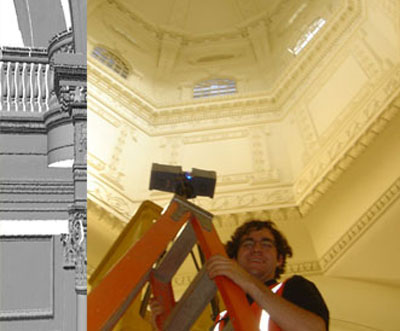Scanning expert Michael Raphael’s 14-year-old company Direct Dimensions, Inc. has evolved to include close-, mid- and long-range scanning services of just about anything. Over the years they have scanned the Lincoln Memorial, Fort Pike in Louisiana, the Liberty Bell, the Tomb of the Unknown Soldier, and many vehicles such as cars, trains, school buses and airplanes–and even people. Their specific expertise is in scanning and modeling close- and mid-range objects and structures, including artwork, sculpture and historic preservation shapes. Whatever the size, cultural preservation projects will always be special to Raphael and his 20-person engineering and modeling team based in Baltimore. “What if a plane hits the Lincoln Memorial? Could we replace Abe in the chair? We should scan these objects now because we can,”says the DDI founder, president and chief engineer.
In addition to future preservation and replacement that would be possible from high-definition laser scans, Raphael also links digital preservation services to the fascinating opportunities a scanning firm can undertake. These jobs may not be the most lucrative compared to their usual industrial market segments, but they do have their purpose: “The idea is to draw business,” Raphael says, pointing out that most of these projects have promotional value and can also be fun and fulfilling. “It’s PR, it’s marketing, and it’s interesting. The good news is [that]it’s growing, and eventually, there will be a very common awareness of the value of this technology. Museums, for example such as the Smithsonian, are acquiring and using 3D technologies to document their collections, and I look forward to visiting their ‘virtual museum’ on the Internet soon,” Raphael says, adding, “and we’re ready to help.”
A recent scanning job undertaken at the historic Maryland State House in downtown Annapolis, Md., cemented Raphael’s speculation that there is a great deal of interest in 3D technology for cultural heritage projects and opportunities for expanding business. “ … [w]hile most long-range scanning customers use the technology to save money or make money, these guys [conservators]want it more for the value of the educational information,” Raphael says.
The State House project consisted of scanning the Old Senate Chamber, the approximately 35-foot square room where George Washington resigned his commission as commander-in-chief of the Continental Army in 1783 and where the Treaty of Paris was ratified ending the Revolutionary War. Direct Dimensions was called in by way of the contractor renovating the State House who urged the Maryland Historical Trust to gather as much information as possible from the already exposed 18th-century brick. DDI took on the project to demonstrate its 3D capabilities and to expose the technology to the conservators and preservationists.
DDI collected about 15 eight- and 10-minute high-accuracy spherical scans with a Basis Software Surphaser 25HSX. They processed the raw data sets in PolyWorks to create ultra high-resolution 3D reconstructions of the actual as-is conditions of the exposed, original brick walls, plaster ceiling, wood plank flooring, architectural columns and railings, a small second-story balcony and other ornamental elements. Deliverables to the State House Trust included a significant amount of technical analysis, such as 2D cross sections and other dimensional information, and a “walk-through” animation and 3D interactive Web-based visualization.
For added PR, DDI also took a quick scan inside the famous State House dome, which is particularly special to the conservationist groups. But the state symbol seen on the Maryland state quarter wasn’t so easy to capture. With their Surphaser mounted on a raised man-lift, DDI techs took a scan inside the dome that begins three stories up to capture its unique geometrical design and decorative moldings. “We figured if we were going to get some PR out of this demo, most of the folks wouldn’t care so much about the room—they care about the dome,” Raphael says.
And PR, it seems, is still the main name of the game for many commercial companies when it comes to cultural heritage projects. “It’s sexy,” he says. “When you show them the animations and the fly-thru’s, that becomes what they’re selling to their sponsors. Then it’s ‘Oh, by the way, we can also make the conservators happy with lots of technical data.’”
Raphael further suggests that a possible business model including historical preservation services is to grab all data of an area or object for free and charge for analysis and modeling.
Capturing and Processing More of Our World
Recent advancements for cultural preservation projects include applying high-resolution color and textures, which Raphael is pleased to see some manufacturers implementing. A continuing challenge for most of their projects including digital preservation, however, is processing the large data sets. “Software needs to support 64-bit so they can use more computer memory,” Raphael says. “Today, in order to process the massive scan data we can collect so quickly, we’re linking our workstations together (such as multiple dual quad-core machines each with eight microprocessors and lots of memory). We can process in hours what took days just a few years ago.”
While he anticipates further technical advancements, Raphael and his inspired and enthusiastic team will continue to enjoy the cool cultural projects that come in through DDI’s door. Any company that can claim it scanned a precise bronze “life mask” of our nation’s 16th president in 3D, as well as a river bank at Valley Forge and the Williamsburg Coffee House (a former political and social center in Virginia), definitely supports the concept of digital preservation as a great marketing tool.






